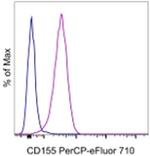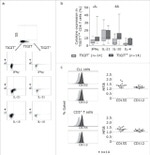Search Thermo Fisher Scientific
Invitrogen
CD155 Monoclonal Antibody (2H7CD155), PerCP-eFluor™ 710, eBioscience™
FIGURE: 1 / 2
CD155 Antibody (46-1550-42) in Flow


Product Details
46-1550-42
Species Reactivity
Published species
Host/Isotype
Recommended Isotype Control
Class
Type
Clone
Conjugate
Excitation/Emission Max
Form
Concentration
Purification
Storage buffer
Contains
Storage conditions
Shipping conditions
RRID
Product Specific Information
Description: The monoclonal antibody 2H7CD155 recognizes CD155 also known as the poliovirus receptor. The CD155 protein is a member of the Ig superfamily in which 4 isoforms exist; only the alpha and delta forms are expressed on the membrane of monocytes, prostate cancer cells, as well as neurectodermal and monocytic tumor cells lines. In addition, CD155 is found during mid-gastrulation during embryonic development. CD155 is thought to play a role in adhesion by interaction with the ECM component vitronectin as well as a role in NK killing of tumor cells. CD226 and CD96 are ligands for CD155. Blocking of CD155 is under therapeutic investigation for prevention of variants of poliovirus.
Applications Reported: This 2H7CD155 antibody has been reported for use in flow cytometric analysis.
Applications Tested: This 2H7CD155 antibody has been pre-titrated and tested by flow cytometric analysis of normal human peripheral blood cells or human tumor cell line U937. This can be used at 5 µL (0.5 µg) per test. A test is defined as the amount (µg) of antibody that will stain a cell sample in a final volume of 100 µL. Cell number should be determined empirically but can range from 10^5 to 10^8 cells/test.
PerCP-eFluor® 710 emits at 710 nm and is excited with the blue laser (488 nm); it can be used in place of PerCP-Cyanine5.5. We recommend using a 710/50 bandpass filter, however, the 695/40 bandpass filter is an acceptable alternative. Please make sure that your instrument is capable of detecting this fluorochrome.
Light sensitivity: This tandem dye is sensitive to photo-induced oxidation. Please protect this vial and stained samples from light.
Fixation: Samples can be stored in IC Fixation Buffer (Product # 00-8222) (100 µL of cell sample + 100 µL of IC Fixation Buffer) or 1-step Fix/Lyse Solution (Product # 00-5333) for up to 3 days in the dark at 4°C with minimal impact on brightness and FRET efficiency/compensation. Some generalizations regarding fluorophore performance after fixation can be made, but clone specific performance should be determined empirically.
Excitation: 488 nm; Emission: 710 nm; Laser: Blue Laser.
Filtration: 0.2 µm post-manufacturing filtered.
Target Information
The protein encoded by this gene is a transmembrane glycoprotein belonging to the immunoglobulin superfamily. The external domain mediates cell attachment to the extracellular matrix molecule vitronectin, while its intracellular domain interacts with the dynein light chain Tctex-1/DYNLT1. The gene is specific to the primate lineage, and serves as a cellular receptor for poliovirus in the first step of poliovirus replication. Multiple transcript variants encoding different isoforms have been found for this gene.
For Research Use Only. Not for use in diagnostic procedures. Not for resale without express authorization.
How to use the Panel Builder
Watch the video to learn how to use the Invitrogen Flow Cytometry Panel Builder to build your next flow cytometry panel in 5 easy steps.
Bioinformatics
Protein Aliases: CD155; FLJ25946; NECL-5; nectin-like 5; Nectin-like protein 5; Poliovirus receptor; sCD112; soluble CD112
Gene Aliases: CD155; HVED; Necl-5; NECL5; PVR; PVS; TAGE4
UniProt ID: (Human) P15151
Entrez Gene ID: (Human) 5817

Performance Guarantee
If an Invitrogen™ antibody doesn't perform as described on our website or datasheet,we'll replace the product at no cost to you, or provide you with a credit for a future purchase.*
Learn more
We're here to help
Get expert recommendations for common problems or connect directly with an on staff expert for technical assistance related to applications, equipment and general product use.
Contact tech support

